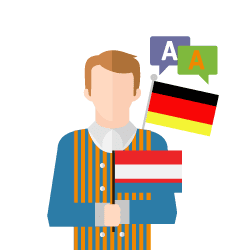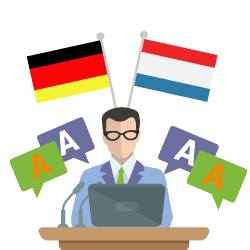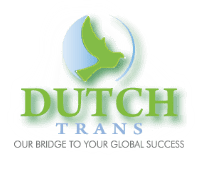
Why Not Translate Dutch to German Using Non-Native Speakers
10 Sep Why Not Translate Dutch to German Using Non-Native Speakers
Translate Dutch to German Using A Native Speaker
Translating Dutch to German with the expertise of a native speaker is crucial for ensuring accurate and culturally appropriate communication. Dutch and German share a rich linguistic heritage, stemming from their common ancestor within the Indo-European language family.
However, nuances such as West Flemish or Franconian dialects and variations in noun declensions and verb conjugations must be carefully navigated to produce a faithful translation. By leveraging the skills of a native German speaker, the translation process can effectively capture the essence of Standard Dutch while adhering to the grammatical and stylistic conventions of the German language.
From literary language to urban dialects, a native speaker possesses an innate understanding of the linguistic subtleties required to convey meaning across the Romance-Germanic Language Border. Whether translating historical texts dating back to the 12th century or contemporary materials for Dutch courses, the expertise of a native German speaker ensures that the translation maintains fidelity to the original text while resonating with German-speaking audiences in both North America and South America.
Being tempted to translate Dutch to German with the cheapest freelancer around is something everyone has thought of. Getting the cheapest services for translation is probably something most are after because no one has bundles of cash to throw at this but, it doesn’t need to be a problem any longer. Native speakers are your best bet.
Why Aren’t Non-Native Translators Good to Use?
The art of translation is a delicate process that involves more than just converting words from one language to another; it requires a deep understanding of linguistic nuances, cultural contexts, and the subtle intricacies that shape effective communication. While non-native translators may possess a level of proficiency in the target language, there are several reasons why they may not be the best choice for translation tasks that demand high-quality standards.
Firstly, non-native translators may lack the intuitive grasp of the target language that native speakers inherently possess. Language is not just about vocabulary and grammar; it is deeply intertwined with culture, history, and social norms. Native speakers have a natural understanding of these elements, enabling them to produce translations that are not only accurate linguistically but also culturally appropriate.
Secondly, non-native translators may struggle to capture the subtle nuances and idiomatic expressions that are integral to effective communication in the target language. Languages often have idioms, metaphors, and colloquialisms that may not have direct equivalents in other languages. Native translators are better equipped to navigate these linguistic complexities and convey the intended meaning accurately.
Furthermore, non-native translators may lack familiarity with regional dialects and variations within the target language. Languages evolve and change over time, and there can be significant differences in vocabulary, pronunciation, and grammar across different regions. Native translators, particularly those who have grown up immersed in the language, are more likely to be attuned to these regional variations and nuances.
In addition, non-native translators may struggle to keep up with changes and developments in the target language. Languages are living entities that evolve over time, with new words, expressions, and idioms constantly entering the lexicon. Native speakers are more likely to be aware of these changes and adapt their language accordingly, whereas non-native translators may rely on outdated or less common vocabulary and expressions.
Overall, while non-native translators may be proficient in the target language to a certain extent, they may not possess the deep understanding, cultural insight, and linguistic intuition that native speakers bring to the table. For translation tasks that require precision, accuracy, and cultural sensitivity, native translators are often the preferred choice to ensure that the final product meets the highest standards of quality and effectiveness.
While non-native translators may possess proficiency in a foreign language such as the Dutch language or Scandinavian languages, their translations may lack the depth of understanding and cultural nuances that native speakers inherently possess. Historical contexts dating back to the 16th century or the 18th centuries may be lost on non-native translators, impacting the accuracy and authenticity of their translations.
Moreover, when translating for specific regions like North America or Pennsylvania Dutch communities, familiarity with local customs and urban dialects is essential for conveying meaning accurately. Publications from reputable sources like Blackwell Publishing may require a level of linguistic expertise that non-native translators may not fully grasp. Additionally, when it comes to practical matters such as bank transfers or dealing with foreign languages, precision is paramount, making native translators the preferred choice for ensuring clear and accurate communication.
Unfortunately, there are a small number of non-native translators who think they can do the job when in reality they can’t. It has left a big and very bad impression on non-natives who can actually translate successfully. However, since there are a small band of non-natives who don’t know what they’re doing, they spoil it for the rest. Translate Dutch to German successfully without a hitch is important and non-natives might pose a problem.
High Quality Standards
High-quality standards in language services, particularly in translation and interpretation, are paramount for effective communication across diverse linguistic landscapes. The Scandinavian languages, each with its unique characteristics, exemplify the importance of adhering to high-quality standards to ensure accurate and culturally sensitive translations. As official and standard languages, they demand meticulous attention to detail and proficiency from translators to convey messages with precision and clarity.
Similarly, West Flemish, a regional language spoken in parts of Belgium, underscores the need for translators to be well-versed in local dialects and nuances. Translating texts from the 16th century requires not only linguistic expertise but also a deep understanding of historical contexts and linguistic evolution to preserve the integrity of the original content accurately.
In the United States, where diverse linguistic communities coexist, including Pennsylvania Dutch speakers, maintaining high-quality standards in translation services is essential for fostering effective communication. Bank transfers, crucial transactions that require precision and accuracy, highlight the importance of reliable translation services to facilitate seamless financial transactions across language barriers.
To uphold high-quality standards in language services, translators must possess not only linguistic proficiency but also cultural competence and subject matter expertise. Adhering to rigorous quality assurance processes ensures that translations meet the needs and expectations of clients while upholding accuracy, consistency, and cultural sensitivity.
High-quality standards in language services are essential for bridging linguistic gaps and facilitating effective communication in a globalized world. Whether translating Scandinavian languages, preserving historical texts from the 16th century, or facilitating bank transfers for Pennsylvania Dutch speakers, adhering to these standards ensures that language services meet the highest levels of accuracy, reliability, and professionalism.
However, in most cases, professional translation services are able to bring a lot more to the table than non-native speakers. They are able to offer very high quality in terms of their accuracy in translation and that is vital! However, professionals can also translate Dutch to German without making those crucial mistakes that often catch non-native speaking translators out.
Quick Turnaround Times
Quick turnaround times are essential in the realm of translation, especially when it comes to translating Dutch to German documents. Whether it’s urgent business correspondence, time-sensitive legal documents, or swiftly translating marketing materials to capitalize on market opportunities, the ability to deliver translations promptly is crucial. Fast-paced global markets demand rapid communication, and efficient translation services that can provide quick turnaround times play a vital role in facilitating seamless cross-cultural communication.
Translators proficient in both Dutch and German, with streamlined workflows and effective project management, can ensure that translations are delivered promptly without compromising quality. This enables businesses and individuals to meet tight deadlines, seize opportunities, and maintain a competitive edge in today’s fast-moving world.
The best thing about using professional translation services is that there won’t actually be long waiting times. Having a fairly quick turnaround time is always going to be important simply because today, no one can afford to wait long for something important. Of course, non-native translators can offer good turnaround times too but they might not be able to deliver without a few sentence structural errors. That is why when someone needs to translate Dutch to German, the native speaking translators are the best to turn to.
Overview of Dutch and German languages
The Dutch and German languages share a close linguistic relationship, stemming from their common ancestor within the Continental West Germanic branch of the Indo-European language family. Dutch, spoken predominantly in the Netherlands and Belgium, is also an official language in Suriname, South Africa, and Sint Maarten. With over 23 million Dutch speakers worldwide, it holds significance as one of the largest languages in Europe.
Meanwhile, German, spoken primarily in Germany, Austria, and Switzerland, boasts over 100 million speakers globally, making it one of the largest languages in the world. Both Dutch and German have evolved over centuries, with roots tracing back to the 12th century and exhibiting influences from Franconian dialects and other West Germanic languages. Despite their shared history, there are notable differences between the two languages, including variations in noun declensions, verb conjugations, and dialect continuum.
Standard Dutch and Standard German serve as the literary languages for their respective regions, while urban dialects and minority languages such as West Frisian and Pennsylvania Dutch contribute to the linguistic diversity within the Romance-Germanic Language Border.
As official languages, both Dutch and German play significant roles in academia, with publishers such as Oxford University Press, Cambridge University Press, and Stanford University Press contributing to the dissemination of knowledge in these languages. Additionally, translation agencies and services facilitate communication between Dutch and German speakers, ensuring accurate and effective translation across various contexts, from business documents to literary works.
The Dutch language has a rich history dating back to the 12th century, evolving within the Continental West Germanic branch of the Indo-European language family. Today, it stands as an official language in various regions, including the Netherlands, Belgium, and parts of South America and South Africa, with millions of Dutch speakers worldwide. Along the German border, Dutch shares linguistic connections with various German dialects, contributing to a dialect continuum that spans both countries.
Despite being a minority language in some regions, such as Sint Maarten, Dutch remains one of the largest languages in Europe and is widely studied through Dutch courses offered globally. The Romance-Germanic Language Border is where Dutch and German intersect, showcasing the linguistic diversity of the region. Within this context, Standard Dutch serves as the literary language, supported by publishing houses like Stanford University Press and Blackwell Publishing.
The University of Toronto Press and John Benjamins Publishing Company also contribute to the dissemination of knowledge in Dutch and related linguistic topics, such as noun declensions and conjugated verbs. In North Brabant and other urban areas, urban dialects add to the linguistic tapestry, alongside West Frisian and West Flemish.
Despite these variations, Dutch translation services and German translation agencies facilitate communication across languages, ensuring that English speakers and speakers of other foreign languages can access information effectively. Multilingual Matters and theWayback Machine play crucial roles in preserving and disseminating linguistic diversity, while bank transfers and other financial transactions highlight the practical applications of language in everyday life.
In the study of Dutch and German grammar, understanding the distinctions between indefinite adjectives, definite adjectives, weak verbs, and n-stem nouns is crucial. These grammatical features, along with the influence of East Germanic languages and the historical contexts of the 16th and 18th centuries, shape the linguistic landscape of both Dutch and German.
Dutch speakers, with their native language proficiency, navigate the complexities of Dutch grammar, while German dialects and the dialect continuum add further nuances to the language. As official languages, Dutch and German serve as standard languages in their respective regions, supported by academic institutions such as Stanford University Press and University Press. Across North America and South America, as well as in regions like Pennsylvania, Dutch speakers encounter diverse linguistic influences, including Scandinavian languages and West Frisian.
The linguistic evolution of Dutch and German, dating back to the 16th century, is evident in publications from Blackwell Publishing and University Press, shedding light on the historical and grammatical intricacies of these languages. In everyday life, financial transactions like bank transfers underscore the practical applications of language, bridging the gap between Dutch and German speakers in a global context.
Translate Dutch to German with Professionals
Translating Dutch to German is a task that requires precision, cultural sensitivity, and linguistic expertise. Dutch and German are both West Germanic languages, sharing many similarities in vocabulary, grammar, and syntax. However, they also have distinct features and nuances that must be carefully navigated to ensure accurate and effective communication.
When translating Dutch to German, it’s essential to understand the specific needs and preferences of German speakers. This includes considering regional variations in German dialects and language usage, as well as cultural differences between Dutch and German-speaking communities. Professional translators who are native speakers of German and have a deep understanding of Dutch linguistic structures are best equipped to handle these complexities.
One of the key challenges in translating Dutch to German is capturing the nuances of the source text while maintaining readability and coherence in the target language. This requires not only linguistic proficiency but also cultural competence to ensure that the translated content resonates with German-speaking audiences.
Professional German translation services play a crucial role in facilitating effective communication between Dutch and German speakers. These services employ experienced translators who specialize in Dutch to German translation, ensuring accuracy, consistency, and clarity in the translated text. Whether it’s translating Dutch documents for business, academic, or personal purposes, professional translation agencies provide reliable and high-quality translation solutions.
Furthermore, translating Dutch to German with professionals offers peace of mind knowing that the translation process is handled by experts who adhere to industry standards and best practices. This includes rigorous quality assurance measures to guarantee the accuracy and integrity of the translated content.
Translating Dutch to German requires more than just linguistic proficiency—it demands a deep understanding of both languages, as well as cultural awareness and sensitivity. By partnering with professional German translation services, individuals and organizations can bridge the language gap effectively and communicate with confidence across Dutch and German-speaking communities.
Everyone is asking whether or not they should use professional services to translate their documents and it is such a difficult question to answer. Sometimes, professional services aren’t needed for a minor word translation or a sentence translation but for anything longer, they are! No one can get good and accurate translation without using the proper services. Is it wise to trust non-native speakers to translate Dutch to German?

The native proficiency in language is always a plus point for professional Translators. Alongside their skill, professional qualifications and experience, their native understanding keeps them ahead of all their competitors.
They hype about native translators is not fabricated, it’s more like quality speaks for itself kind of thing. People who have used native translators to translate Dutch to German have seen precision in their work like none other. They render services beyond just words. With their grip on the colloquial and routine language, they can use humor and rough according to the context given.
In our opinion if you want to gain more customers and you can do that by translating Dutch to German, then we suggest you to not mess it up. Choose native professional Translators and get the highest quality services for your business translations. Don’t let a momentary decision ruin your future business growth and select wisely.


